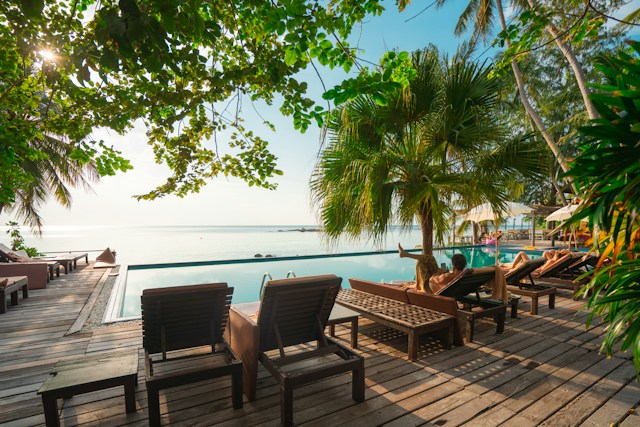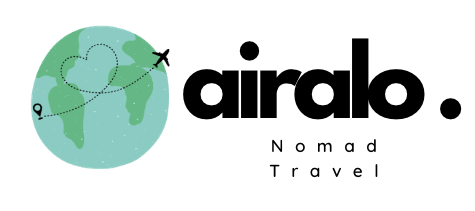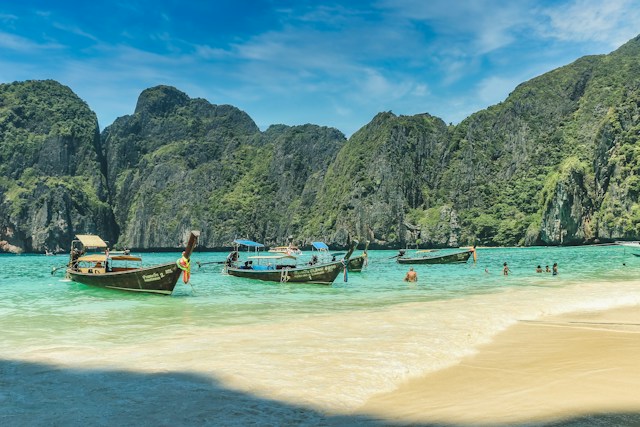
Thailand has long been a popular destination for digital nomads and expatriates, with its beautiful beaches and excellent vacation spots. But is it really that easy to be a digital nomad in Thailand? What difficulties and challenges do we face when living the real-life in Thailand? This article gathers three real-life experiences from Thai digital nomad YouTuber to seek answers based on living expenses and challenges faced.
Current situation and environment in Thailand
According to current statistics, the digital nomad scene in Thailand is quite active. Thailand has attracted many digital nomads to live and work in the country due to its relatively low cost of living, beautiful attractions, and friendly environment.
Bangkok:
In particular, Bangkok is one of the most popular cities for digital nomads in Thailand. It offers modern infrastructure, a rich cultural scene, a variety of food options, and numerous coworking spaces and cafes suitable for digital work. Additionally, locations such as Koh Samui, Chiang Mai, and Phuket have also attracted many digital nomads, offering them the opportunity to work and live in beautiful beach and natural landscapes.
However, is it really the case in reality? We can gather insights from the YouTube video by YouTuber Tuomas Kivioja titled “I Became a Digital Nomad in Thailand for 30 Days. Here’s What Happened.” Tuomas Kivioja, being from Finland, initially found that the reality of Bangkok was a bit rougher than the dream, despite it being an international metropolis. Some shortcomings exist. From Tuomas Kivioja’s YouTube video:
“For the first time, my first impressions were definitely mixed. The airport was chaotic, I didn’t know how anything worked, I didn’t speak the language, and I couldn’t even read the language. And when I arrived at the hotel, the first thing to happen was my internet didn’t work. The streets were chaotic and everything like that. “
“And while certain things certainly didn’t objectively work as well as in Europe, the streets were dirty, there were all these wires hanging, and I was like, “Okay, if I touch this wire, I’m probably gonna die.’“
Chiang Mai:
However, from the YouTube video “The REAL Cost of Thailand’s Digital Nomad Paradise” by One Shot Adventures, we see a different side of Thailand. One Shot Adventures is a YouTuber who has been living in Chiang Mai for a long time. Chiang Mai is the second-largest city in Thailand. Most tourists see it as a place with ancient city walls, unique temples, and proximity to exotic wildlife and stunning natural landscapes. However, when it comes to choosing a place for long-term residence, it often differs from the tourist destinations. Let’s see what One Shot Adventures has to say:
“When it comes to long-term living, many foreigners are drawn to this small district away from the city walls, and that place is Nimman. It gets its name from the Nimmanhaemin Road, the busy main street that runs right through its center. And thanks to its proximity to the Changai University campus, over the years, it’s become one of the most modern and vibrant areas in Northern Thailand. But these days, it’s probably best known as a digital nomad hotspot, attracting remote workers and experts from all around the globe, leading it to become a place where Thailand very much collides with the Western world. So, this is where the love-hate divide comes in. Some people will argue that the main problem with this area is that it doesn’t really feel like Thailand. Nimman has a very Western vibe. So, it all comes down to what you’re looking for in a place to live.“
Koh Samui:
For digital nomads who enjoy living on islands, which is the best choice? The answer provided in the YouTube video “Is THAILAND Still the Best Destination for DIGITAL NOMADS in 2024” by Joose the Nomad is:
“Bangkok is a big city, and it’s really nice. Phuket is an island, but more developed. Koh Phangan is a smaller island with nature and nice vibes, and it’s really chill. But the best digital nomad communities we have seen in these islands are in Koh Phangan and also in Phuket, so I recommend Koh Phangan probably the most for a longer stay.“
The best mode of transportation in Thailand:
What is the best city to choose in Thailand? Here is a common answer from two YouTubers: renting a local motorcycle. This is how Tuomas Kivioja describes it:
“We rented some mopeds for literally nothing. We would just ride around the island. I’m sure there are traffic rules in there, but if they exist, then people don’t really follow them, which again is crazy. It comes with this sense of freedom. If you feel like you can do anything, you don’t have to worry about all these rules and regulations.”
Joose the Nomad also describes the convenience of riding motorcycles in Thailand:
“But probably one of our favorite things about Thailand is the scooter is just so easy to get around. It’s such a freedom. It’s the best thing in this destination. Just a few minutes’ drive anywhere is so easy. No waste of time ever, and it’s just a really nice experience. “
Of course, if you choose a highly convenient neighborhood that has all the hardware and facilities you need, walking becomes your best option. One Shot Adventures describes it this way:
“What Nimman offers in abundance is convenience, convenience, and Comfort, especially for people who work online, is another great aspect of this area, which is exactly why we decided to spend some more time here. Another great thing about this area is that you don’t really need to have your own mode of transport because Nimman is just so walkable.“
Cost of transportation:
The cost is an important factor when it comes to transportation. When digital nomads are living in Thailand and looking for the best mode of transportation, what are the expenses like? Let’s see the feedback from Tuomas Kivioja:
“When we were taking taxis and tuk-tuks around Bangkok, it would probably be like 200 baht for a 15-minute ride or something like that. Although those tuk-tuks were definitely charging us the Western tourist prices, it was super fun, so it’s worth it. The mopeds that we rented in Koh Samui were 3,000 baht for the entire month per person, which is really good.“
Expenses:
Food, drinks, accommodation, and transportation are the most important aspects for everyone. So, how do digital nomads living in Thailand choose their expenses? And how does it compare to Western European countries? Based on the description from YouTuber Tuomas Kivioja, we can conclude that it is cheaper:
“You can either keep the same standard of living as you are used to in the West, except pay a lot less for it, so reduce your costs dramatically. Or option two, you can maintain the same costs but drastically upgrade your lifestyle. So essentially, you get a lot more for what you pay for.“
Accommodation:
First and foremost, accommodation is a crucial part. Let’s start with Tuomas Kivioja, a YouTuber living in Bangkok. Bangkok is the most popular place for digital nomads in Thailand and also the capital city. So, what are the expenses like in the capital? Tuomas Kivioja compares it as follows:
“We stayed in this massive villa that’s basically the same price as the comment that I have here in Dubai, and it was on the hills, overlooking the entire island. It was magical, and it only cost us, I think it was like 3,500 pounds a month split between the two of us, which I know is not like the true authentic experience of Thailand. I’m going one step at a time here.”
Tuomas Kivioja chose to maximize his living experience in Thailand while maintaining his daily expenses.
Now, let’s see the choice of One Shot Adventures, a YouTuber living in the Nimman area in Chiang Mai. Are they choosing the first option or the second option?
“I think this apartment is really, really nice, and we got it for a really good price. We rented this place directly with the rental office for 15,000 Baht per month, and we did have to pay one month’s rent ahead of time as a sort of deposit. Now, that price doesn’t include our Wi-Fi, water, or electricity. So before we break down those costs, I think we need a bit of a change of scenery. Just a 10-minute bike ride from the streets of Nimman is one of my favorite spots in the whole of Changi, a popular meeting place with some of the best views around. And the perfect place to unwind as the sun starts to set. Something we made a habit of doing at least a few nights each week. So now, join me from the edge of the Angal Reservoir, which is a beautiful spot here inside Changi University. This is where loads of people come in the evenings to do some jogging or just walk around and enjoy the views. It’s so nice around here, and it also provides the perfect backdrop to talk about those final numbers from our stay at the Nana. So, I’m going to let voiceover Ryan take over to make sure I get them exactly right.
I’ve now run the final numbers for our monthly costs, and this is what they are. First of all, for high-speed internet from the 3bb network, we paid 632 Baht per month, and it was pretty good for our entire stay. Our electricity bill was, on average, 1,550 Baht per month, which included a lot of sitting around in the apartment, working on laptops with the air conditioning on. Our water bills were only 120 Baht per month. And we paid for professional cleaning twice a month at 300 Baht each time, bringing our average monthly bills to 292 Baht. So including the 15,000 for rent, it was 17,921 each month, which we split between the two of us.”
Obviously, both YouTuber chose the second option. Now let’s see the choice of the third YouTuber:
“We got was in Copan and $600. We got this amazing apartment with a kitchen and two rooms. Really nice location, close to the beach.”
Food Expenses
Eating is a crucial part, so let’s take a look at the expenses related to eating out for digital nomads. YouTuber Tuomas Kivioja says, “And just as a side note, often the best food you will eat in Thailand, at least in our experience, are precisely the cheaper places. Some of our favorite places to eat were some of those very cheap street food places where we’d spend like 200 baht for a dinner. Whereas at one point, we went to this kind of fancy Beach Club, and the dinner ended up costing us like 60-70 bucks or something like that, and it was the worst meal we had out of any meal we had on our entire trip.“
If you want a clearer idea, such as the cost of a cup of coffee, you can find out everything from YouTuber One Shot Adventures’ description of specific expenses in the higher-cost Nimman area of Chiang Mai:
“In a fancy Niman cafe, it will set you back as much as 100 baht for an artisan brew, but you can also find more humble shops where a local Thai coffee will cost you only 20 to 40 baht. And it’s the same when it comes to food. A pizza or pasta dish at a Niman Italian restaurant will cost you around 300 to 400 baht, but going local will save you a lot. The smaller Thai or other Asian stores will only cost you around 40 baht a dish or less. And if you ask me, it’s even tastier. And then…
There’re the markets. Nimman’s night market culture is pretty unique compared to the rest of Chiang Mai. At the southern end of the Main Street, you’ll find more space. This place is predominantly made up of food trucks, which are again very affordable with a lot of variety. And the views aren’t too bad either.“
Cost of entertainment
Now, let’s talk about the cost of entertainment. After understanding the expenses related to food, let’s see the approximate expenses for entertainment. We can learn from YouTuber Joose the Nomad:
“Nothing is too expensive to do every now and then. And speaking of nice things to do, we’re going to do a massage, and that’s so nice in Thailand. Thai massage is always so good. This is like the most expensive massage we had in Thailand, but the place looks nice. I think because it’s a better place and it’s a tourist area, and also high season, so that’s why it’s pricey. But it’s definitely worth the 25 dollars. I was feeling so stiff before, but so much better now. It’s nice in Thailand. I usually go at least once a week because I work with a computer a lot and I feel so stiff, and then I go for a massage once a week and I feel perfect most of the times. That’s the nice part about living in Thailand.”
In summary, so far, we can see that living in Thailand comes with certain challenges and requires some adaptability, especially for digital nomads from different cultures, such as those from European or American countries. However, it also comes with the opportunity to enjoy the best seaside views and immersive natural beauty, experiencing the most beautiful scenes of nature early in the morning. If you are a digital nomad who enjoys challenging new environments, Thailand is definitely not to be missed!
This article references the following video sources:
If you have more questions or need assistance with tax-related matters, feel free to leave a message or add our official WeChat account to access a range of professional services, including tax planning, consulting, immigration, and digital nomad assistance.





